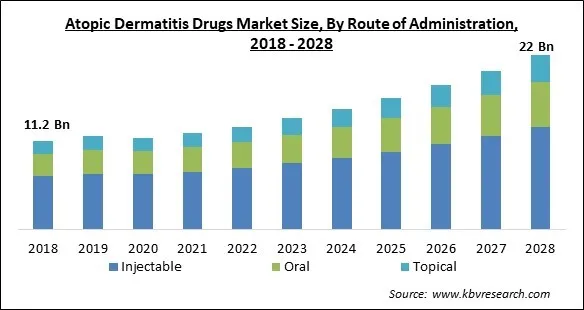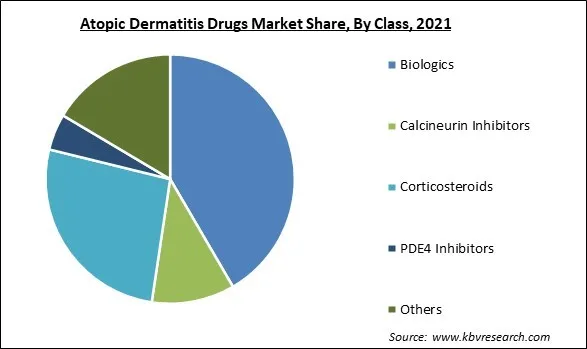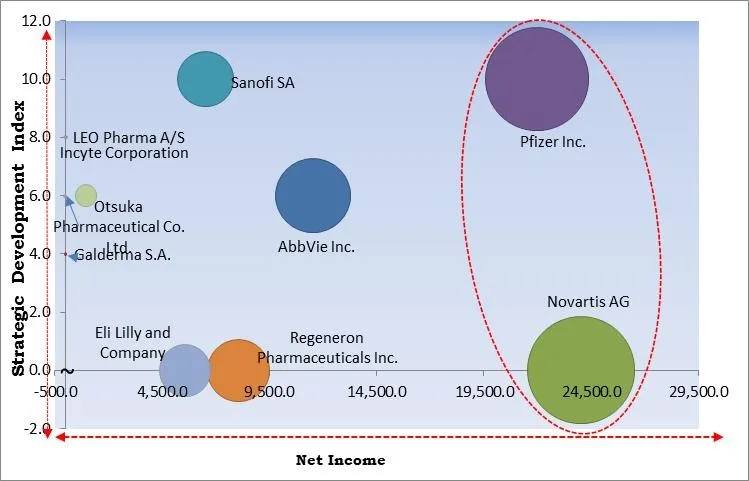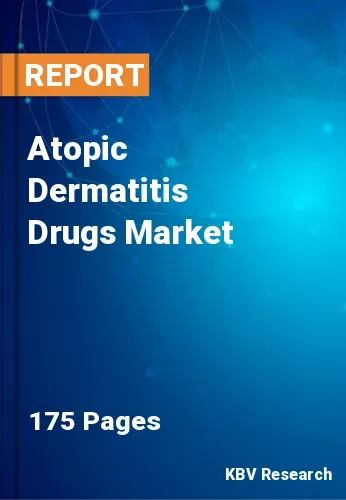The Global Atopic Dermatitis Drugs Market size is expected to reach $22 billion by 2028, rising at a market growth of 9.2% CAGR during the forecast period.
Eczema, commonly referred to as atopic dermatitis, is a skin ailment that affects the skin and results in itching, dryness, and inflammation. The illness has a potential for chronicity and occasionally flares up and spreads. Drugs for atopic dermatitis, such as atopic eczema steroids, are utilized to treat eczema, lessen itching, and treat other atopic dermatitis-related disorders.

Atopic dermatitis patients run the risk of acquiring asthma, hay fever, and food allergies. Regular moisturizing and other skin care practices help reduce itching and stop future outbreaks. Medicated lotions or ointments may also be used during treatment. It causes skin that is scratchy, red, swollen, and cracked. The damaged sites may leak a clear fluid that thickens over time.
Although the disorder can strike at any age, it usually first manifests in childhood and varies in severity throughout time. Much of the body may be impacted in youngsters under the age of one year. The areas on the inside of the knees and elbows are most frequently affected as kids age. Adults are more frequently afflicted in the hands and feet.
Scratching the affected regions makes the symptoms worse, and individuals who are scratching have a higher chance of developing skin infections. Atopic dermatitis frequently leads to the development of asthma or hay fever. Avoiding things that aggravate the illness, regular bathing followed by the use of moisturizing cream, using steroid creams when flare-ups happen, and drugs to relieve itching are all part of the treatment.
Wool garments, soaps, fragrances, dust, chlorine, and cigarette smoke are a few things that frequently aggravate it. Some people may benefit from phototherapy. If other treatments are ineffective, steroid tablets or lotions based on calcineurin inhibitors may occasionally be employed. If a bacterial infection manifests, antibiotics (by mouth or topically) could be required. Only if food allergies are detected are dietary modifications required.
The coronavirus is still creating trouble in people's lives on a worldwide scale, disrupting everything from social interactions to how they seek medical care and see the outside world. Every industry has experienced a profit or output decrease as a result of the pandemic epidemic. However, the market for treating atopic dermatitis has anticipated a substantial impact because of the irregularity of hospital visits by patients. Teledermatology has grown during the crisis when the majority of patients continue to receive generalized care and/or additional consultative therapies without seeing a doctor in person.
The treatment of dermatological disorders, particularly atopic dermatitis, has changed as a result of the use of biologic drugs in dermatology. Biologics have demonstrated a good response to atopic dermatitis, improving the overall quality of life. As a result, there is now a greater demand for biologic treatments for atopic dermatitis. In the upcoming several years, this pattern is probably going to continue. For the time being, only one biologic product has been authorized for the treatment of atopic dermatitis. Many more are currently through phase II clinical studies and will probably be approved soon.
The increasing prevalence of atopic dermatitis medications around the world is anticipated to be the main factor driving the market for atopic dermatitis medications. A large number of people suffer with atopic dermatitis which is expected to rise even more in upcoming years. Geographical location, climatic circumstances, socioeconomic level, lifestyle, age, gender, inheritance, and individual behaviors all have an impact on the prevalence of dermatological problems around the world. An individual with atopic dermatitis must deal with allergies on a daily basis.
Topical steroid treatments lasting fewer than four weeks are often risk-free and trouble-free. Long-term topical steroid use or frequent repetition of short doses of harsher steroids may cause issues. The primary issue is the prolonged usage of potent steroids. Mild topical steroids rarely have side effects. Topical steroids may have local or systemic side effects. Systemic refers to an issue that affects the entire individual, whereas local refers to that particular area of skin.

Based on class, the atopic dermatitis drugs market is segmented into corticosteroids, calcineurin inhibitors, PDE4 inhibitors, biologics and others. In 2021, the corticosteroids segment acquired a substantial revenue share in the atopic dermatitis drugs market. Many conditions, such as inflammatory bowel disease, rashes, and asthma, can be successfully treated with corticosteroid medications, such as cortisone, hydrocortisone, and prednisone.
On the basis of route of administration, the atopic dermatitis drugs market is fragmented into topical, injectable and oral. In 2021, the injectable segment held the largest revenue share in the atopic dermatitis drugs market. This is due to the rising popularity of injectable drugs like Dupilumab. Tofacitinib and ruxolitinib are other injectable biologics being studied in clinical trials. In the near future, biologics are anticipated to alter the therapy landscape for AD.
| Report Attribute | Details |
|---|---|
| Market size value in 2021 | USD 12.2 Billion |
| Market size forecast in 2028 | USD 22 Billion |
| Base Year | 2021 |
| Historical Period | 2018 to 2020 |
| Forecast Period | 2022 to 2028 |
| Revenue Growth Rate | CAGR of 9.2% from 2022 to 2028 |
| Number of Pages | 175 |
| Number of Tables | 282 |
| Report coverage | Market Trends, Revenue Estimation and Forecast, Segmentation Analysis, Regional and Country Breakdown, Competitive Landscape, Companies Strategic Developments, Company Profiling |
| Segments covered | Route of Administration, Class, Region |
| Country scope | US, Canada, Mexico, Germany, UK, France, Russia, Spain, Italy, China, Japan, India, South Korea, Singapore, Malaysia, Brazil, Argentina, UAE, Saudi Arabia, South Africa, Nigeria |
| Growth Drivers |
|
| Restraints |
|
Region wise, the atopic dermatitis drugs market is analyzed across North America, Europe, Asia Pacific and LAMEA. In 2021, the North America region led the atopic dermatitis drugs market by generating the highest revenue share. The availability of a well-established R&D infrastructure and kind reimbursement rules are two major factors contributing to the region's sustained dominance. Additionally, the regulatory and reimbursement environment is constantly changing to keep up with the rapid advancement of research in this field.
Free Valuable Insights: Global Atopic Dermatitis Drugs Market size to reach USD 22 Billion by 2028

The major strategies followed by the market participants are Acquisitions. Based on the Analysis presented in the Cardinal matrix; Pfizer, Inc. and Novartis AG are the forerunners in the Atopic Dermatitis Drugs Market. Companies such as AbbVie, Inc., Sanofi SA, Regeneron Pharmaceuticals Inc. are some of the key innovators in Atopic Dermatitis Drugs Market.
The market research report covers the analysis of key stake holders of the market. Key companies profiled in the report include Pfizer Inc., Sanofi SA, AbbVie Inc., Galderma S.A., Eli Lilly and Company, Leo Pharma A/S, Regeneron Pharmaceuticals Inc., Otsuka Pharmaceutical Co. Ltd., Novartis AG, and Incyte Corporation.
By Route of Administration
By Class
By Geography


The global Atopic Dermatitis Drugs Market size is expected to reach $22 billion by 2028.
Growing Demand For Biologics are driving the market in coming years, however, Side Effects Of Topical Steroids restraints the growth of the market.
Pfizer Inc., Sanofi SA, AbbVie Inc., Galderma S.A., Eli Lilly and Company, Leo Pharma A/S, Regeneron Pharmaceuticals Inc., Otsuka Pharmaceutical Co. Ltd., Novartis AG, and Incyte Corporation.
The Biologics segment is leading the Global Atopic Dermatitis Drugs Market by Class in 2021 thereby, achieving a market value of $8.5 billion by 2028.
The North America market dominated the Global Atopic Dermatitis Drugs Market by Region in 2021, and would continue to be a dominant market till 2028; thereby, achieving a market value of $9.5 billion by 2028.
Our team of dedicated experts can provide you with attractive expansion opportunities for your business.

